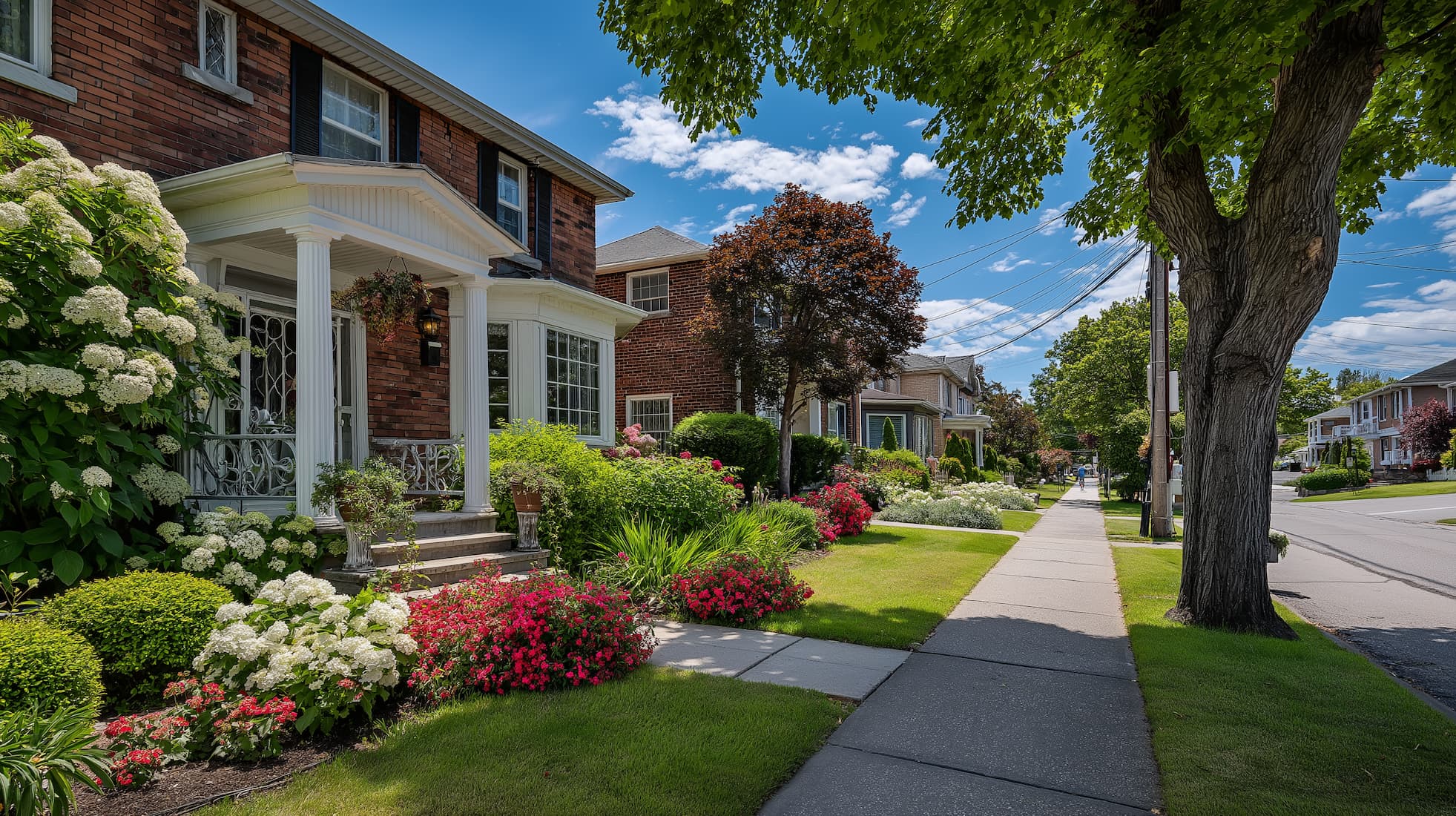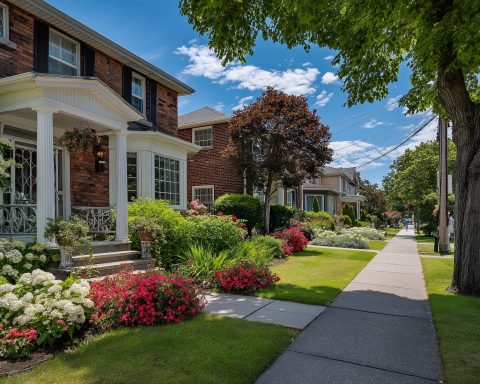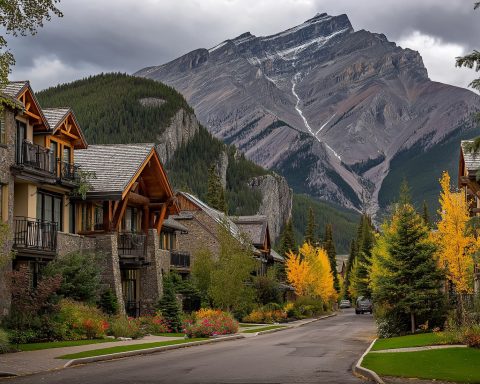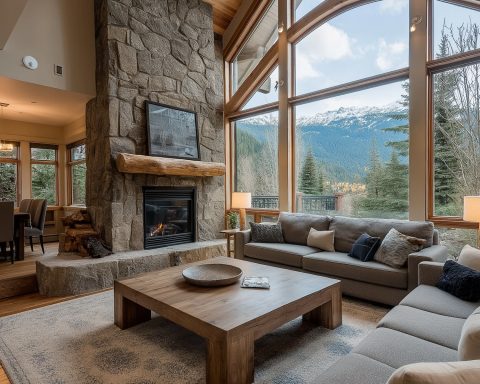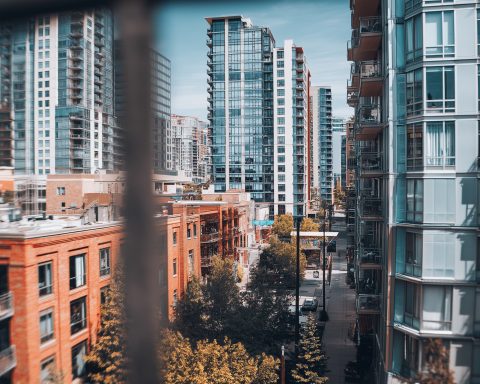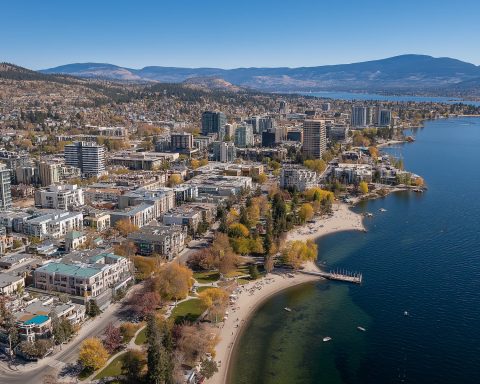- Cross-Border Price Gap: The Canadian side (Niagara Falls, ON) has an average home price around C$660,000 as of August 2025 (down ~4.6% year-over-year) creastats.crea.ca, while the U.S. side (Niagara Falls, NY) sits around $180,000 median sale price (up ~2.6% YoY) redfin.com – a huge affordability divide.
- Tourism Rebound Fuels Demand: Niagara Falls draws over 13 million tourists annually spending $2+ billion niagaracanada.com, reviving the hospitality market. Hotel revenues have surpassed pre-pandemic levels (RevPAR ~122% of 2019 in 2024) businessviewmagazine.com, and visitor volumes hit new highs – energizing both residential rentals and commercial projects.
- Hotel & Casino Building Boom: Development is surging on both sides. Niagara Falls, NY has 18 new hotels (6,000+ rooms) in the pipeline businessviewmagazine.com and plans for a $200 million events arena to extend the tourist season businessviewmagazine.com. Not to be outdone, Niagara Falls, ON approved a twin-tower complex (two ~60-story high-rises) with 1,140 hotel suites, 126 condos, plus a new casino – set to redefine the skyline storeys.com.
- Residential Market Trends: Niagara Falls, ON’s housing market is stabilizing after the 2020–2022 boom – average prices dipped slightly in 2024 creastats.crea.ca but are projected to rise ~2% by end of 2025 blog.remax.ca. Sales volumes have cooled (forecast ~11% fewer sales in 2025) amid higher interest rates blog.remax.ca, tilting the market from a pandemic-era seller’s market to a balanced tone. Niagara Falls, NY, by contrast, saw modest price growth off a low base (e.g. +2–3% YoY in 2025) redfin.com, with homes still ultra-affordable by national standards. Buyer demand on the U.S. side is steady but tempered by slow population growth.
- Rental Markets Diverge: The Canadian side’s rents are much higher – around C$2,035 median rent in Niagara Falls, ON (Oct 2025) zumper.com – versus roughly $1,225 in Niagara Falls, NY zumper.com. U.S. rents, though low, jumped ~23% year-over-year amid tightening supply zumper.com, while Canadian rent growth has been gentler (~2–4% YoY) zumper.com. Strong tourism also drives a robust short-term rental market (e.g. Airbnb) in Niagara Falls, ON, though local regulations and competition from hotels keep it in check.
- Commercial & Industrial Uptick: Niagara’s industrial real estate is booming. In early 2025, industrial property sales in the region doubled vs. the prior year (11 sales in Q1 2025 vs 5 in Q1 2024) blog.remax.ca. Despite a 30%+ jump in industrial listings, vacancies remain low – pushing lease rates to $12–$14 per sq. ft. in Niagara (slightly less than nearby Hamilton’s $15) blog.remax.ca. Retail space is scarce in both Niagara Falls cities, with small storefronts in high demand – almost every strip plaza has a waitlist, and lack of 1,000–5,000 sq. ft. units is putting upward pressure on retail rents blog.remax.ca.
- Infrastructure & Development Projects: Major projects promise to boost real estate. Niagara Falls, ON now enjoys daily GO Train service from Toronto storeys.com, enhancing commuter and tourist access – a selling point for investors and second-home buyers. On the U.S. side, the city (with New York State) is investing in downtown revitalization: e.g. restoring the historic Hotel Niagara and building the Centennial Park event center (6,000-seat arena) businessviewmagazine.com. Additionally, Niagara Falls, NY opened a new 60-acre industrial park to diversify beyond tourism, leveraging its low-cost hydropower to lure manufacturers (one wind turbine parts plant already bought 15 acres) businessviewmagazine.com. These investments signal confidence in sustained growth and are catalyzing surrounding property values.
- Regulatory Contrast: The Canadian side’s real estate is shaped by tighter regulations – Ontario imposes a 25% foreign buyer tax on residential purchases wowa.ca (and until recently, a temporary foreign-buyer ban nationwide), as well as rent controls on older units. These policies aim to curb speculation and protect affordability, moderating price spikes. In contrast, the U.S. side has no foreign-buying restrictions and relatively landlord-friendly rules (e.g. no state rent control for small cities), making Niagara Falls, NY potentially attractive for international investors seeking higher yields. Government incentives also play a role: New York offers grants, tax abatements, and Opportunity Zone designations in parts of Niagara Falls to spur development, whereas Ontario provides some development charge discounts and community improvement programs, but with more regulatory oversight on land use and the environment.
Residential Real Estate Trends in Niagara Falls (Canada vs. U.S.)
Niagara Falls, Ontario – Housing Market: The residential market on the Canadian side experienced a rollercoaster in recent years. During the 2020–2022 period, ultra-low interest rates and urban buyers fleeing Toronto drove Niagara Falls home prices sharply upward. By late 2022, average home prices neared all-time highs (around $800k) emberandresolve.com. However, as interest rates rose and federal policies tightened, the market cooled in 2023. By August 2025, the average home price was ~$663,000, about 4–5% lower than a year prior creastats.crea.ca. This slight year-over-year decline reflects a market correction from the earlier overheating. Inventory has built up to the highest in a decade creastats.crea.ca, giving buyers more choice and negotiating power. Indeed, Niagara shifted from a seller’s market in 2021 to a balanced market in 2024–2025 creastats.crea.ca creastats.crea.ca, with months of inventory around 6–7 months (a far cry from the frenzy of 1–2 months inventory during the peak) creastats.crea.ca.
Despite the recent moderation, fundamentals remain resilient. Demand is supported by steady population growth – Niagara Falls city grew ~7.2% from 2016 to 2021 (to ~94,000 residents) and the broader Niagara Region grew ~6.8% in that period niagararegion.ca niagararegion.ca. Much of this growth comes from migration: people relocating from the Greater Toronto Area and newcomers to Canada. In 2024 alone, over 10,000 new residents moved to the Niagara Region, about a quarter from the GTA emberandresolve.com. Many are families and retirees attracted to Niagara’s affordable lifestyle, natural beauty, and border proximity. This influx underpins housing demand, especially for single-family homes in commuter-friendly communities. Indeed, regional realtors report that family buyers remain the primary drivers of home sales, with first-time buyers (often in their 30s+) now re-entering as prices stabilize blog.remax.ca.
Price trends in 2025 have been flat-to-modestly positive after the 2023 dip. Between January and July 2025, Niagara’s average sale price inched up ~2.4% (from ~$660k to $676k) as the market found equilibrium blog.remax.ca. Analysts expect about 2% price growth through end of 2025 blog.remax.ca – a far cry from the double-digit jumps of the boom, but a sustainable pace given higher borrowing costs. Sales volumes, on the other hand, are subdued – forecast to be ~11% lower in 2025 vs. 2024 blog.remax.ca as some buyers remain cautious or priced out. The luxury segment and sought-after neighborhoods (e.g. Niagara-on-the-Lake, or upscale pockets of Niagara Falls) are propping up the averages, even as overall transaction counts slow blog.remax.ca. Move-up buyers tapping accumulated equity are active, while some prospective buyers sit on the sidelines awaiting clearer economic signals. Sellers have had to adjust expectations from last year’s peak – homes now take longer to sell (typical DOM over 30 days) and conditional offers are common again, indicating a return to normalcy.
Within the city, different sub-markets are emerging. Properties near tourist areas or with falls views command premium prices and interest from investors (for rentals) and international buyers (when allowed), whereas suburban subdivisions offer more moderate prices and attract local families. Niagara Falls also benefits from spillover demand from St. Catharines and Hamilton – as those markets became expensive, buyers looked further down the QE-W highway. As a result, even with the recent dip, Niagara Falls home values in 2025 remain well above pre-pandemic levels (the MLS benchmark price is ~$610k, ~+45% vs. 2019) creastats.crea.ca. Housing supply is slowly responding: new home construction is underway in outskirts and infill condo projects, but building has lagged demand. Large developers have focused on the Greater Toronto Golden Horseshoe broadly, and Niagara Falls is now on their radar for new subdivisions as land is relatively cheaper and infrastructure improving. Over the next few years, modest new housing inventory (especially townhomes and condos) is expected to come online, which should help keep price growth in check. For now, Niagara Falls, ON’s housing outlook is one of cautious optimism – moderate price increases, more balanced buyer-seller dynamics, and opportunity for those priced out of bigger cities, as long as interest rates don’t spike again.
Niagara Falls, New York – Housing Market: On the U.S. side of the Falls, the real estate story has been quite different. Niagara Falls, NY is a challenged market emerging from decades of decline. The city’s population has shrunk by more than half since the 1960s, and even recently it continues to dip (~0.6% drop from 2022 to 2023) datausa.io. A legacy of industrial collapse and economic stagnation left many homes vacant or low-value, keeping prices extraordinarily low. Even today, the median home value hovers around $165,000 zillow.com (Zillow’s index) and the median listing price is about $150–$160k realtor.com – roughly one-quarter of the U.S. national median. Homes in some neighborhoods can be found well under $100k, especially older properties in need of repair. This affordability reflects both the low incomes in the area (median household income ~$48k datausa.io) and the excess housing supply left by population loss.
However, 2024–2025 has seen glimmers of a turnaround. The housing market in Niagara Falls, NY has shown small but meaningful appreciation. In August 2025, the median sale price was about $180,000 (up 2.6% year-on-year) redfin.com, marking consecutive annual gains. Some price indexes even show double-digit listing price growth (realtor.com noted +14% YoY in listing median) realtor.com, indicating sellers are testing higher asking prices. Part of this is driven by an influx of outside investors and home flippers taking interest in Niagara Falls’ rock-bottom prices. The prospect of the city’s revival – with new tourism and downtown projects – has sparked speculative buying of distressed properties, many of which are then renovated into rentals or budget tourist accommodations. In addition, out-of-town landlords (including some from Canada) have been purchasing multi-family homes to capitalize on rising rents. This new demand is slowly absorbing inventory: the number of homes on market has tightened compared to a few years ago, and days-on-market has shortened (homes now sell in ~19 days on average, down from 30+ a few years prior) redfin.com. While still not a “hot” market, Redfin rates Niagara Falls as “somewhat competitive” redfin.com – a notable improvement from its previously very sluggish state.
A key factor in the U.S. side’s housing is the city’s revitalization efforts. The local government has targeted blighted housing through grants and code enforcement, even buying up derelict properties. One innovative move is partnering with Niagara University to convert clusters of vacant homes into student housing, concentrating students in a planned area rather than scattered rentals businessviewmagazine.com businessviewmagazine.com. This initiative is rehabilitating dozens of structures (38 properties in the North Main “Bridge District”) and has started in 2024 businessviewmagazine.com. By removing blight and creating demand (students), the project aims to uplift property values in those neighborhoods. It also reflects the city’s strategy to repurpose its surplus housing stock rather than build anew. On the flip side, new residential construction in Niagara Falls, NY remains limited – few large-scale housing developments are underway, given the existing inventory and still-recovering market conditions.
The character of demand on the U.S. side is mostly local and regional. Many buyers are from within Western New York – first-time buyers taking advantage of very low prices (where a 3-bedroom house can cost what a down payment might in other markets), or investors from Buffalo and beyond. There is also some Canadian interest: the strong U.S. dollar and home price gap make Niagara Falls, NY an intriguing buy for some Canadians, especially those priced out at home. For under C$200k, one can own a rental property just across the border. There are reports of a few adventurous GTA-area investors picking up Niagara Falls, NY duplexes and single-fams as income properties, betting on long-term appreciation. However, cross-border real estate investment is still relatively niche due to financing and management hurdles.
In summary, Niagara Falls, NY’s housing market in 2025 is affordable and slowly improving. Prices are inching up from a very low base, demand is gradually rising thanks to city improvements and outside interest, and rental yields are attractive. Yet, challenges remain: the city’s population is still shrinking slightly datausa.io, and many neighborhoods struggle with poverty and property disinvestment. The pace of appreciation is likely to stay modest unless broader economic fortunes change. For now, Niagara Falls, NY offers a stark contrast to its Canadian twin: it’s essentially a value play – “cheap and hopeful” – whereas Niagara Falls, ON is “costly but comparatively stable.”
Commercial Real Estate and Tourism-Driven Development
Tourism & Hospitality Real Estate: Tourism is the economic lifeblood of Niagara Falls, and its impact on commercial real estate is profound on both sides of the border. After the severe downturn in 2020, tourism has roared back with a vengeance. By 2024, the Niagara region (mainly the Canadian side) hosted over 13 million visitors, who spent an estimated $2.4 billion in the local economy niagaracanada.com. Niagara Falls, NY likewise saw record visitor spending in 2024 (Niagara County tourism revenues hit ~$1.16 billion, up 6.4% from 2023) wgrz.com. This rebound has led to surging demand for hotels, restaurants, and attractions, directly influencing real estate development:
- Hotel Construction Boom (U.S. side): Perhaps the most dramatic development is unfolding in Niagara Falls, New York’s hotel sector. The city is experiencing a hotel building boom unprecedented in decades. As of 2025, 18 new hotel projects, totaling over 6,000 rooms, are in development businessviewmagazine.com on the U.S. side. These range from big-brand franchises (e.g. a new 126-room SpringHill Suites opening in 2025 businessviewmagazine.com) to boutique hotels and renovations of historic properties. For example, the long-vacant Hotel Niagara (a 1920s landmark) is under restoration with the help of state incentives, slated to reopen as an upscale hotel. Many new projects are clustered around Old Falls Street and downtown, aiming to create a critical mass of hospitality options that can finally rival the Canadian side. This boom is fueled by a recognition that Niagara Falls, NY has been under-hoteled – many visitors currently stay in Buffalo or across the border. The new supply seeks to capture more tourist spending locally. Notably, hotel performance metrics have recovered strongly: by 2024, Niagara Falls, NY’s hotel revenue per available room (RevPAR) was 122% of 2019 levels businessviewmagazine.com, meaning the average hotel was earning more than before the pandemic, despite slightly lower occupancy. This indicates visitors are spending more per room (higher rates or more add-on spending), a good omen for investors. The city’s strategy is clearly to leverage its 12+ million annual visitors (many of whom historically only did day-trips) into overnight stays by offering new accommodations and attractions.
- Mega-Projects (Canadian side): On the Ontario side, commercial development is also accelerating, albeit with a different flavor – vertical expansion and diversification. The marquee project is a proposal to replace the aging Oakes Hotel at Fallsview with a massive mixed-use complex featuring two 60-storey towers storeys.com. This development would add 1,140 new hotel suites along with 126 luxury residential units (likely condos) and a host of amenities including a new casino, spa, rooftop pools, and retail space storeys.com storeys.com. Essentially a self-contained resort, it would be one of the tallest and most ambitious builds in Niagara Falls, ON’s history. The plan underscores developers’ confidence in Niagara Falls’ tourism growth – betting that demand will support high-end hotel rooms and condos with premium views of the Falls. The site’s clear views and proximity to major attractions (casinos, Clifton Hill, etc.) make it prime real estate storeys.com. If approved and built over the coming years, this project would inject hundreds of millions in new investment and further cement the Canadian side’s reputation for flashy skyline-defining towers. Beyond that, Niagara Falls, ON continues to see new attractions (for instance, the Niagara Parks Commission recently repurposed a decommissioned power station into an immersive history attraction and is adding a theatre and entertainment complex there youtube.com) and expansions of existing ones. Tourism-oriented retail (souvenir shops, restaurants) is also in high demand around the Falls and Clifton Hill; occupancy rates for these remain extremely high, and rents command a premium due to foot traffic.
- Extending the Tourist Season: A major goal on both sides has been to expand tourism beyond the summer peak. This has implications for real estate use year-round. Niagara Falls, NY’s planned Centennial Park events center (a $200 million, 6,000-seat venue) is a key piece in this puzzle businessviewmagazine.com. Expected to host concerts, sports (the mayor is courting an Ontario Hockey League team) and conventions, it would draw visitors in the off-season and spur demand for nearby hotels and dining even in winter businessviewmagazine.com. Similarly, the Canadian side opened the Niagara Falls Convention Centre (2011) and a new 5,000-seat entertainment theatre (opened 2020) near Fallsview Casino, which have started to attract conferences and shows year-round. As these facilities ramp up, they increase mid-week and off-season hotel occupancy, making the hospitality business more stable annually. The ripple effect is increased investor interest in hotels and short-term rentals, since cash flow becomes less seasonal. For instance, hotels in Niagara Falls, NY traditionally closed or went half-empty in winter; with the events center and improved downtown amenities, more hotels can justify year-round operation, supporting values.
- Short-Term Rentals: Tourism has also given rise to a robust short-term rental (STR) market, especially on the Canadian side. Niagara Falls, ON has hundreds of Airbnb and vacation rentals, from apartments to entire houses, that cater to tourists preferring space or lower cost than hotels. This trend picked up during COVID (when travel resumed, many preferred private rentals). STR demand has propped up values for some residential properties near tourist areas – a small house in walking distance to the Falls can fetch a premium if it can be rented nightly. The city of Niagara Falls, ON has enacted bylaws requiring STR operators to be licensed and adhere to safety and zoning rules, aiming to balance this sector. On the U.S. side, short-term rentals are fewer but growing; the city has been cautiously supportive of STRs as a way to activate vacant homes, but it also monitors for nuisance issues. Overall, tourism’s strength translates into a unique blend of residential-commercial use in Niagara Falls: many properties blur the line (e.g. owner-occupied B&Bs, Airbnbs, etc.), and the health of the tourism economy is directly tied to these property incomes. Given the current trajectory – international travel rising, border mobility back to normal, and new attractions coming – the hospitality-driven real estate segment looks poised for continued growth.
Retail and Entertainment Commercial Space: Beyond lodging, Niagara Falls’ retail and entertainment real estate is benefiting from increased consumer spending by tourists and locals alike:
- On the Canadian side, the tourism district (Clifton Hill, Fallsview) is essentially fully built-out with retail, dining, and entertainment venues. Vacancy in these areas is near zero, and any available unit sees intense competition. Rents have been climbing post-pandemic. According to regional market reports, small retail spaces (1,000–1,500 sq ft) and mid-sized units (3,000–5,000 sq ft) are in very short supply, which is “starting to place upward pressure on retail lease rates.” Almost every strip plaza or mall in Niagara has a waiting list of tenants looking to take space blog.remax.ca. This is not only tourist shops – local-serving retail in Niagara Falls (grocery-anchored plazas, etc.) also enjoys low vacancy due to the growing population and relatively few new retail developments in recent years. One interesting project is the Eastgate Square revitalization in nearby Stoney Creek/Hamilton (though not in Niagara Falls, it’s in the greater region) which plans to add 19 residential towers to a mall site blog.remax.ca, reflecting a trend of intensifying retail sites with mixed-use. Niagara Falls could see similar trends – for instance, older motels or strip malls on Lundy’s Lane might redevelop into mixed-use with condos above shops, given land scarcity near the tourism core.
- On the U.S. side, downtown Niagara Falls, NY is finally seeing nascent retail revival. Historically, the city’s retail was blighted – many empty storefronts on Main Street. The influx of tourists staying longer (thanks to new hotels and the state park upgrades) is attracting businesses: new restaurants, breweries, cafes, and shops have begun opening around Old Falls Street and Third Street. Mayor Restaino noted “several new restaurants as well as entertainment venues, distilleries and microbreweries” are setting up downtown businessviewmagazine.com. The city has also focused on “family-friendly” chain restaurants to cater to tourists with children businessviewmagazine.com – e.g. new fast-casual dining options. Commercial rents downtown are still relatively low (to incentivize tenants), but as spaces fill up, we may see upward pressure. Outside the tourist area, retail in Niagara Falls, NY remains challenging – many neighborhoods lack basic shopping options due to the population decline. But any improvement in employment or population could spur demand for more retail services (stores, supermarkets) in the city, which in turn could breathe life into neighborhood commercial strips.
Industrial and Office Sectors: While tourism dominates, Niagara Falls is also seeing activity in industrial real estate and grappling with office market shifts:
- Industrial & Logistics: The Niagara Region (Ontario) has become a hotspot for logistics, warehousing, and some advanced manufacturing, thanks to its strategic location bridging the GTA and the US border. In 2025, industrial real estate in Niagara is in a growth phase, partly because land and operating costs are lower than in Toronto/Hamilton, drawing interest from companies blog.remax.ca. The data shows industrial property transactions jumped and listings increased ~35% YoY in Niagara Region, yet vacancy remains so low that lease rates have climbed to ~$12–$14/sqft (triple-net) blog.remax.ca. A lack of serviced industrial land is noted – both Niagara and Hamilton have shortages of shovel-ready industrial parcels blog.remax.ca. In Niagara Falls, ON specifically, there are industrial zones (e.g. along Stanley Ave and in the east end) that are attracting new businesses such as distribution centers. The region’s economic development is actively promoting “Electric Mobility” and advanced manufacturing niagaracanada.com; for example, recent investments include an electric bus manufacturing facility in the region. This translates into increased demand for industrial buildings and development land. Investors in industrial real estate (REITs, private firms) have started paying attention to secondary markets like Niagara due to yield opportunities, as prime markets have become pricey. One caution is the cost of capital: rising interest rates initially cooled some industrial investment, but the outlook for 2025 is optimistic as financing conditions improve and pent-up demand is realized cbre.ca.
- Niagara Falls, NY Industrial Push: On the American side, Niagara Falls is reinventing some of its derelict industrial areas. The city famously had large chemical and manufacturing plants (e.g. along Buffalo Avenue) that closed decades ago, leaving contaminated sites and job losses. In 2024, the city opened a new 60-acre industrial park north of Porter Road as a modern business park businessviewmagazine.com. It has a compelling selling point: cheap, abundant hydroelectric power from the nearby Niagara Power Project. This is a big draw for energy-intensive industries or any company seeking lower operating costs. According to the Mayor, a wind turbine parts manufacturer (Stony Creek) was the first to purchase land there, and multiple Canadian firms have shown interest in establishing a U.S. footprint in this park businessviewmagazine.com. With New York State’s support (about $3.25M to get the site shovel-ready) businessviewmagazine.com, the park is positioned to attract manufacturers, possibly in aerospace, medical equipment, or green energy sectors businessviewmagazine.com. If successful, this will create jobs and increase demand for both industrial and office space in Niagara Falls, NY. It could also spur some ancillary development (e.g. worker housing or retail) in that part of the city. For now, industrial real estate prices in Niagara Falls, NY are very cheap (land is plentiful), but if even a few mid-sized employers move in, we could see significant absorption of space and rising land values after years of stagnation.
- Office Space: Niagara Falls is not a major office market, but some trends are noteworthy. In Niagara Falls, ON, most employment is in tourism, services, or government – office space is limited and there haven’t been major new office builds. Nearby St. Catharines functions as the regional administrative center (with more office inventory). Post-pandemic, office vacancy has risen slightly regionally as remote work persists, but Niagara never had a huge downtown office scene to begin with. On the U.S. side, office vacancy in the broader Buffalo-Niagara area has been elevated (Buffalo’s downtown has ~20%+ vacancy) blog.remax.ca. Niagara Falls, NY doesn’t have big office towers; small professional offices and government buildings make up much of its office stock. Some older office buildings are candidates for conversion to mixed-use or residential if demand doesn’t recover. The city is focusing more on revitalizing downtown for tourism and residents rather than trying to attract large office employers, given broader trends in remote work and the competitive disadvantage in office vs. Buffalo.
In sum, commercial real estate in Niagara Falls (both sides) is being reshaped by a booming tourism economy and strategic development efforts. Hospitality and retail are thriving, industrial is an emerging bright spot, and office space takes a back seat. Investors and developers are seizing opportunities in hotels, attractions, and industrial parks, which could transform the economic landscape of Niagara Falls in the coming years.
Economic Drivers and Factors Affecting Demand & Supply
Several key factors drive real estate demand, supply, and values in Niagara Falls, and many of them differ between the U.S. and Canadian sides:
- Tourism and the Local Economy: As emphasized, tourism is the engine. Anything that affects tourism (global travel trends, exchange rates, gas prices, pandemics) directly hits local real estate. The Canadian side, with a more developed tourist economy (casinos, major attractions, etc.), is somewhat cushioned by a consistently high visitor baseline. Tourism supports about 40,000 jobs in Niagara Region niagaracanada.com and a whole ecosystem of businesses. This provides a steady pool of renters and homebuyers (hospitality workers, managers, etc.), though many tourism jobs are low-wage, creating demand for affordable housing. On the U.S. side, tourism is also crucial but historically under-realized; now that it’s growing, it represents potential upside for the economy. More tourist spending means more jobs, higher incomes, and possibly population stabilization or growth – all boosting housing demand. However, Niagara Falls, NY’s broader economy is still diversifying. Efforts to attract manufacturing and logistics (as discussed with the industrial park) could bring in higher-paying jobs, which would be a game-changer for housing demand quality. If, say, a large factory or two open, demand for middle-class housing would increase, reducing the surplus and pushing prices up. Conversely, if tourism were to falter (imagine a recession curtailing travel, or a weak Canadian dollar discouraging Canadian visits to the U.S. side), these markets would feel it quickly.
- Population Trends and Migration: Demographics are a fundamental driver. Niagara Falls, ON benefits from positive migration – both interprovincial and international immigration into the region. Canada’s high immigration rates (a record number of new permanent residents each year) funnel some newcomers into affordable secondary cities like Niagara Falls. The region’s attractiveness to retirees (due to its scenery and wineries) and remote workers (improved train connectivity to Toronto means some can live in Niagara and commute occasionally) also boosts demand. This influx of people keeps pressure on housing supply and underpins long-term growth; it’s a reason realtors call Niagara “undervalued” relative to its potential clovermortgage.ca. In contrast, Niagara Falls, NY has struggled with population loss for decades due to out-migration of younger people and lack of inbound migration. One positive sign: the city’s population decline has slowed to a trickle in recent years datausa.io. If the city can manage even a small net population gain (through job creation or by attracting immigrants who settle in Buffalo/Niagara), that would mark a turning point. For now, though, the shrinking/aging population on the U.S. side limits housing demand. Many homes remain vacant or underutilized. Supply isn’t the issue there – demand is. Thus, real estate values in Niagara Falls, NY hinge on the city’s ability to draw and keep residents (be they workers, retirees, or even people seeking low-cost living).
- Interest Rates and Financing Environment: Real estate globally has been impacted by the sharp rise in interest rates since 2022. In Canada, higher mortgage rates significantly eroded buyers’ affordability, which helped cool Niagara Falls’ previously hot market. If rates remain high (~5-6%+ for 5-year fixed mortgages), we can expect muted price growth and longer sales cycles as buyers budget more carefully. Conversely, any rate relief (as some forecasts suggest moderate rate cuts by 2025–2026) joinremaxm.com could unleash pent-up demand, especially from first-time buyers who have been sidelined. On the commercial side, the “cost of capital crisis” has been a concern – projects penciled when money was cheap became harder to finance at higher rates. Notably, CBRE’s 2025 outlook suggests that this financing burden will ease in late 2025, potentially reigniting investment and development activity cbre.ca. For Niagara Falls, that could mean borderline projects (like some hotel proposals or condo towers) secure financing and proceed. In the U.S., interest rates also influence investor behavior. Many Niagara Falls, NY home purchases are cash (given low prices), but for larger developments, financing costs are a factor. The city and state have stepped in with low-interest loans or subsidies for some projects to bridge the gap. An environment of stabilizing or falling interest rates would greatly benefit Niagara Falls on both sides by improving affordability and encouraging development.
- Cross-Border Dynamics (Exchange Rate and Trade): The exchange rate between the U.S. and Canadian dollars plays a subtle but important role. A strong USD (and weaker CAD) tends to attract more American visitors to the Canadian side (their money goes further) and can entice Canadian shoppers to stay home. It can also make Canadian real estate relatively cheaper for U.S. or international investors (when CAD is low). As of 2025, the USD-CAD rate is around 1.35 (CAD per USD), making Canadian assets somewhat discounted for foreigners. However, foreign buyer restrictions (discussed below) limit direct exploitation of that. Trade and cross-border employment also matter: Niagara Falls sits on a major trade corridor (Queenston-Lewiston Bridge for trucks, etc.). The health of cross-border commerce can influence demand for industrial land, warehouses, and even housing for workers who might live on one side and work on the other. For instance, if the U.S. economy is strong, more Canadians might cross for jobs or shopping, and vice versa. Integrated tourism is another factor – many tourists visit both sides (stay in one, visit the other for a day). Cooperative marketing by Niagara Falls tourism bodies can thus raise the overall pie, benefiting real estate by boosting the local economies.
- Infrastructure and Accessibility: Improvements in transportation and infrastructure can significantly affect real estate. The GO Train extension to Niagara Falls, ON (now with a few direct trains from Toronto on weekdays and expanded weekend service) storeys.com makes it feasible for some commuters and certainly easier for tourists without cars. This has put Niagara Falls on the map for some GTA-based remote workers and retirees who still want easy city access, thereby increasing demand for housing. Ongoing highway improvements and the planned hovercraft link from Niagara Region to Toronto (a private proposal to run a 30-minute hovercraft service across Lake Ontario cbre.ca) could further boost connectivity. On the U.S. side, infrastructure investment has included state park enhancements (improving the park and waterfront – New York invested heavily to restore green spaces around the falls). There’s also talk of high-speed rail in Upstate NY which, if it materializes, could better link Niagara Falls to NYC and other metros. Additionally, the Niagara Falls International Airport (in NY) is courting more flights, and the Buffalo Niagara Airport’s growth indirectly benefits the region. All these factors improve Niagara Falls’ attractiveness as a place to visit and live, thus supporting real estate values.
- Supply Constraints and Land Availability: Land availability differs starkly across the two cities. Niagara Falls, ON has geography and policy constraints – it’s bounded by the river, the escarpment, and other municipalities, and much land is protected (parks, greenbelt). The city proper has limited greenfield land left; thus new development often means building upward (high-rises) or redeveloping existing sites. For example, the proposed twin towers are replacing an older hotel – a pattern likely to continue. This relative scarcity of developable land close to the falls helps support high property values. The Greenbelt and zoning regulations in Ontario also restrict sprawl, focusing growth in built-up areas. On the flip side, Niagara Falls, NY has an abundance of vacant land and empty lots due to demolition of decayed properties and past population loss. The city has “urban prairie” in some areas reddit.com. In theory, this means plenty of room to build – a boon for supply. But without demand, that land goes unused. The city is trying to channel development to certain zones (tourist district, Main Street, industrial park) rather than sprawl, to create momentum. If demand does pick up, Niagara Falls NY could add new housing or facilities relatively easily and cheaply. One interesting supply-side factor: the cost of construction. In Ontario, construction costs are quite high (labor, materials, development charges), which can slow down new housing supply and keep prices elevated for existing homes. In Western New York, costs are somewhat lower, plus the government often offsets costs through incentives for chosen projects. This difference can influence how quickly each side can bring new supply to market in response to demand shifts.
Regulatory Environment and Government Plans
The real estate landscape in Niagara Falls is also shaped by government policy and regulations, which differ between Canada (Ontario) and the U.S. (New York). Understanding these is crucial for investors and stakeholders:
Canada (Niagara Falls, ON) Regulations & Policies:
- Foreign Buyers and Speculation: In an effort to cool housing prices, the Canadian federal government enacted a foreign-buyer ban (2023–2025) preventing non-residents from purchasing residential property (with some exceptions). Ontario, on top of that, has the Non-Resident Speculation Tax (NRST) – a hefty 25% tax on foreign purchasers of residential real estate anywhere in the province wowa.ca. These measures have had some impact in Niagara Falls: while not a primary target for foreign investors compared to Toronto or Vancouver, Niagara Falls did see interest from overseas (e.g., investors eyeing vacation homes or rental properties near the Falls). The NRST and ban likely dampened that demand in 2023–24. As the ban expires, there could be a minor uptick in foreign interest, but the 25% tax still acts as a strong deterrent wowa.ca. The province is keen to avoid speculative spikes in affordable regions like Niagara, aiming to reserve housing for locals and long-term residents.
- Rent Control and Tenant Protections: Ontario has a system of rent controls on most older residential units. For Niagara Falls, this means landlords of units built before Nov 2018 can only raise rents by a provincially-set guideline each year (2.5% in 2025). Newer builds are currently exempt from rent control (to encourage development), but any changes to provincial policy could alter that. These rules ensure relatively stable rental increases for sitting tenants, but they also can dissuade some investors from entering the long-term rental market, potentially limiting rental supply. Niagara Falls, being a smaller city, hasn’t seen the intense rental regulation debates of Toronto, but it follows Ontario’s framework. Additionally, strong tenant protections (e.g., eviction rules) make the rental market more regulated than in the U.S. This adds a layer of security for renters but is a consideration for landlords’ business models.
- Development Charges and Permitting: Building in Niagara Falls, ON involves development charges (fees paid to the city for infrastructure) and navigating zoning bylaws, which can be complex, especially near the Falls where height and view corridor restrictions may apply. The city does offer some incentives like Community Improvement Plans (CIPs) in certain areas – for example, downtown Niagara Falls has a CIP offering grants/fee rebates to encourage residential conversions and redevelopment. The Niagara region also has the Gateway CIP aimed at attracting industrial development with tax breaks niagaracanada.com. These incentives signal a willingness to partner with developers for projects that meet community goals (like more housing or employment). That said, Ontario’s regulatory process (including environmental assessments, heritage considerations, etc.) can be lengthy. A project like the twin towers proposal will undergo rigorous review (traffic, shadow studies, perhaps opposition from residents concerned about skyline impact). Government plans, such as the Niagara Region Official Plan, direct most new housing to existing urban areas and set targets for affordable housing – policies that will influence what kind of projects get approved.
- Property Taxes: Niagara Falls, ON has moderate property tax rates (the city and region tax combined). Taxes did rise after the huge run-up in assessments (since home values increased, assessed values did too), but the city has tried to keep the tax rate reasonable to not deter newcomers. In fact, Niagara Falls’ 2024 city budget slightly reduced residential property taxes by 3.1% businessviewmagazine.com thanks to fiscal improvements. For investors, the tax environment is fairly stable, though non-resident owners might also face a vacant home tax if a property is left empty (some Ontario cities have implemented such taxes to encourage usage).
United States (Niagara Falls, NY) Regulations & Initiatives:
- Incentives and Revitalization Programs: Niagara Falls, NY’s government is taking a very pro-development stance, using incentives to jump-start the market. Key players include the USA Niagara Development Corporation (a state economic development agency focused on downtown Niagara Falls) and the Niagara County Industrial Development Agency (IDA). They offer inducements like tax abatements, low-interest loans, grants, and land subsidies for projects that will create jobs or boost tourism. For instance, developers of new hotels might receive property tax breaks (PILOT programs) for a decade. Recently, the Niagara County IDA granted extensions on incentives for the Hotel Niagara restoration to ensure the project moves forward hotel-online.com. The city also has an Opportunity Zone covering parts of downtown, offering federal tax advantages to investors. These aggressive incentives reflect the policy goal: attract investment at almost any cost to revitalize the city. This is a stark contrast to the Canadian side’s stance of cooling an overheated market – Niagara Falls, NY is trying to heat up a cold one.
- Zoning and Land Use: Niagara Falls, NY has been updating its zoning to be more flexible and friendlier to mixed-use and infill development. They’ve streamlined approvals for projects in the tourist district and offered city-owned land at low cost to developers who will build. For example, the city packaged and sold a bundle of vacant lots to a developer consortium for $1 each in exchange for commitments to build housing (the student housing project). Such land banking and disposition strategies are a tool being used to reduce blight. Building codes and permitting in Niagara Falls, NY are governed by New York State standards (which are strict on safety/energy but not nearly as onerous as Ontario’s for planning). This regulatory environment can often mean lower soft costs and faster approvals for development in Niagara Falls, NY, especially if the project aligns with city priorities.
- No Rent Control / Fewer Housing Regulations: New York State has rent stabilization laws, but they largely apply only to NYC and a few downstate counties. In Niagara Falls and Niagara County, there’s no rent control, no foreign buyer tax, no primary residence requirements – the market is relatively laissez-faire. Landlords can raise rents as the market allows and evict for nonpayment more readily (subject to normal lease law). This can make the rental investment proposition attractive (as seen by the 23% YoY rent hike in 2025) zumper.com, but it also poses affordability challenges for local low-income renters. The city has to balance encouraging investment with protecting residents – hence it works with non-profits on providing affordable housing (there are HUD-subsidized apartments and Section 8 vouchers in use to aid renters, given the city’s high ~24% poverty rate datausa.io).
- Economic Development Plans: The city leadership has a comprehensive plan to diversify the economy so real estate isn’t solely reliant on tourism whims. Mayor Restaino’s administration is investing a cited $70 million in development projects across downtown and neighborhoods businessviewmagazine.com – including streetscape improvements, new public facilities, and private-public partnerships. The state has poured money via the Downtown Revitalization Initiative (DRI) grant Niagara Falls won, funding facade improvements, cultural attractions, etc. These plans foster an environment where private real estate development is more likely to succeed (since the public sector is handling some groundwork). For instance, a nice streetscape and event programming on Old Falls Street make opening a cafe there much more viable. In short, Niagara Falls, NY’s regulatory posture is “open for business,” leveraging public funds to catalyze private real estate growth.
Cross-Border Collaboration or Divergence: It’s worth noting that while the two Niagara Falls operate under different systems, there is some degree of cooperation. Both cities share the goal of increasing tourism and have occasionally coordinated on things like cross-border promotions. However, in real estate, they are more often competitors – e.g., for attracting a new hotel or a new investor, each side touts its advantages (the Canadian side: stability, higher visitor numbers, established market; the U.S. side: low costs, big incentives, untapped potential). From a regulatory perspective, an investor will find the U.S. side offers lower upfront barriers (cheap land, subsidies) but also less proven returns, whereas the Canadian side is costlier to enter (higher prices, taxes) but offers a robust existing market.
Looking ahead, government actions will continue to heavily influence Niagara real estate. If Ontario were to relax foreign buyer rules or invest in affordable housing in Niagara, it could stimulate the market further. If New York were to reduce its support or if political leadership changes, Niagara Falls, NY’s renaissance could slow. For now, policy is aligned in both places to encourage sustainable growth: Niagara Falls, ON focusing on smart growth and affordability (to prevent overheating), and Niagara Falls, NY focusing on growth and investment (to overcome stagnation).
3–5 Year Outlook: Projections, Opportunities, and Risks
What does the future hold for Niagara Falls real estate? Both sides of the border face distinct trajectories, but generally, the next 3–5 years (2026–2030) are expected to bring continued growth with some cautionary factors. Below is an outlook, highlighting opportunities and risks:
Price and Market Trajectory:
- Niagara Falls, Ontario: Housing prices are likely to resume a gentle upward climb after the recent correction. Forecasts call for low single-digit annual price growth – on the order of 2–5% per year – assuming interest rates stabilize or fall modestly blog.remax.ca. By 2028, the average home price in Niagara Falls could be in the mid-$700Ks (CAD) range under this scenario. This growth will be supported by ongoing immigration to Canada, spillover from the expensive Toronto market (Niagara will continue to look like a bargain in comparison), and the region’s desirability. If remote/hybrid work remains common, more GTA employees might choose Niagara for its affordability and commute occasionally by GO train, further boosting demand. Commercial property values (hotels, etc.) on the Canadian side should also rise given strong revenue trends – we may see cap rate compression if more investors (possibly REITs or hotel chains) try to acquire Niagara assets on expectations of rising tourism income. One thing to watch: the completion of big projects like the twin towers/casino around 2027–2028 (if they proceed). Such a huge influx of hotel rooms and some condos could, in the short term, saturate the market and soften prices or occupancy until demand catches up. Overall, though, Niagara Falls, ON’s real estate outlook is positive, with the main limiting factor being broader economic conditions (e.g., if a recession hits Canada, Niagara would feel the effects via fewer buyers and tourists).
- Niagara Falls, New York: The U.S. side is poised for gradual appreciation in residential real estate – perhaps a bit faster than inflation if revitalization succeeds, but likely not explosive. One long-term forecast (by WalletInvestor) predicts steady rises in Niagara Falls, NY home values through 2030, reflecting a belief in slow growth. Even a 3% annual gain on a $160k median would bring it to ~$185k in three years, ~$200k in five years – still extremely affordable. There’s significant upside potential if, say, a major employer comes or if a wave of buyers from outside “discovers” Niagara Falls as an investment haven. But there are risks that could keep values flat: ongoing population decline or failure of development projects to deliver promised economic boosts. Commercial prospects on the U.S. side are more exciting: by 2028, downtown Niagara Falls could be markedly transformed – numerous new hotels up and running, the events center drawing year-round visitors, and a livelier nightlife/dining scene. This would push up rents and property values downtown. We might even see new mixed-use residential projects (lofts, apartments over retail) as demand for living near the action increases. The city’s tax base would improve, allowing further reinvestment in services and infrastructure, ideally creating a virtuous cycle. However, if some hotel projects stall due to financing or if visitor numbers don’t meet projections (a risk if economic or travel trends go awry), there’s a possibility of overbuilding. An oversupply of hotel rooms could lead to price wars and foreclosures, a scenario investors must consider. The same goes for retail – if too many shops open banking on tourists and locals, some may fail if spending is insufficient.
Key Opportunities:
- Undervalued Assets: Niagara Falls, NY presents an opportunity to acquire real estate at basement prices in a location with unique global name recognition. Investors who rehabilitate properties can gain good rental yields (given rising rents) and equity upside if the city’s revival continues. On the Canadian side, opportunities exist in slightly out-of-core areas – e.g. properties a bit away from the Falls that could appreciate as the city expands or as retirees seek quieter corners of Niagara with lower prices than tourist hub condos.
- Niche Development: There is room for niche projects: e.g. seniors housing/retirement communities to cater to aging boomers drawn to Niagara’s lifestyle, vineyard estate developments in Niagara region (leveraging wine tourism), or more Green/Sustainable projects (both cities could convert brownfields to eco-friendly developments, aligning with environmental trends). Niagara Falls, ON’s emphasis on sustainability might see new builds touting energy efficiency and green design as selling points to eco-conscious buyers.
- Cross-Border Synergy: The two cities could benefit from cooperation – joint tourism initiatives, perhaps even co-marketing for conventions (stay on one side, visit the other). If border crossing processes are eased (for example, expanded pre-clearance or technology to reduce wait times at bridges), it effectively enlarges the “market” by making it easy for people to live on one side and work or play on the other. A person could live in Niagara Falls, ON and work in Niagara Falls, NY’s emerging tech or industrial sector, or vice versa, if crossing becomes frictionless. This synergy can enhance real estate demand broadly in the area, treating it as one binational region.
- Infrastructure and Large-Scale Events: Looking ahead, Niagara Falls is rumored to be considering bids for large events (perhaps hosting parts of the FIFA World Cup 2026 activities, or more likely, aiming for events like the Canada Summer Games or U.S. state tournaments). Big events bring a surge of visitors and sometimes catalyze infrastructure upgrades (as the Pan Am Games did for Toronto/Hamilton in 2015). Any such win could temporarily boost the hospitality market and leave a legacy of improved facilities (which bolster real estate appeal long-term).
Key Risks:
- Economic Downturn: A global or regional recession in the next 1–3 years is a significant risk. Niagara Falls is highly sensitive to economic cycles, especially discretionary travel. If high inflation and interest rates persist or if unemployment rises, tourism could dip as people cut travel spending. This would directly hurt hotel revenues, push some restaurants out of business, and could even lead some of those new hotel projects to halt construction mid-way due to financing trouble. The housing markets would also feel it: Niagara Falls, ON could see price declines if GTA demand dries up and locals face job uncertainty, while Niagara Falls, NY might slip back into decline if its nascent economic shoots are trampled by a recession. Essentially, Niagara Falls needs a healthy economy to thrive, more so than diversified metros.
- Interest Rates and Policy Changes: If interest rates were to spike further or stay very high, it would crimp the real estate outlook. Development projects might become unfeasible (debt too expensive), buyers would have trouble qualifying for mortgages (especially in Canada with strict stress tests), and cap rates would rise (reducing commercial property values). On the flip side, there’s also policy risk in the form of regulation: Canada might extend or expand foreign buyer restrictions if home prices nationally take off again, and Ontario’s government could always adjust rent control rules (for instance, removing the new-build exemption would make investors less keen on building rentals). In New York, a risk (though currently low) is if the state ever considered expanding rent stabilization upstate in response to affordability issues; that could catch investors off guard.
- Project Execution Risk: A lot of Niagara Falls’ optimistic outlook hinges on big projects being completed and successful. There is inherent risk in that – construction delays, cost overruns, or even cancellations can occur. For example, the Centennial events center in NY has critics who question if the revenues will justify the cost businessviewmagazine.com. If that project were scaled back or canceled, it would dampen some of the positive momentum and leave downtown without a key anchor. Similarly, the twin tower project on the Canadian side is still in proposal stage; if it doesn’t get approved or if financing falls through, it might signal that the market isn’t ready for that scale of development, tempering bullish sentiment. Real estate investors should be mindful that not all announced projects materialize – due diligence on those in the pipeline is necessary.
- Oversupply & Market Saturation: There is a risk, albeit a welcome problem in some ways, that Niagara Falls could experience growing pains from its own success. If all the planned hotel rooms come online, the market must absorb a huge increase in capacity. Should tourism growth even pause, occupancy rates could plummet and room rates drop, straining hotel operators (especially newer, debt-laden ones). In housing, if Niagara Region overbuilds certain types of housing (say, too many high-end condos targeted at GTA buyers), there could be a glut that softens prices for years. Niagara Falls, ON has a few condo projects completing; if investor buyers don’t materialize or if Airbnb rules tighten, some units could lie empty, affecting market perception. Essentially, managing growth will be important – authorities and developers will need to calibrate supply additions to real demand to avoid booms turning to busts.
- Environmental and Social Factors: Niagara Falls must also consider environmental risks. Being on a major waterway, there’s minimal risk of flooding by the Falls itself due to controlled flow, but climate change could affect Great Lakes water levels and weather patterns (heavy snowfall, etc.). Any significant environmental event could impact tourism (e.g., if parts of the park are damaged or if summer heatwaves make visits less pleasant). Socially, Niagara Falls, NY must ensure that development benefits local residents – if revitalization only focuses on tourists and outsiders, existing communities might feel left behind, leading to political pushback or social issues. Safety and perception also matter: Niagara Falls, NY has fought a reputation of being unsafe or dilapidated in some areas; sustained improvement is needed to truly change that image, which in turn affects real estate desirability.
Outlook Summary: Both Niagara Falls, ON and NY are on an upward path as of 2025, albeit starting from different points. The Canadian side will likely see stable growth built on its established tourism industry, gradually rising population, and proximity to Toronto – it will continue to be one of Ontario’s real estate bright spots, though not without its affordability challenges for locals. The U.S. side is an emerging turnaround story – the next 5 years will be critical to see if it can transition from decades of decline to a new growth phase. If current plans come to fruition, Niagara Falls, NY in 2030 could be a very different city: more tourists staying downtown, new residents moving into rehabbed lofts or new apartments, and a diversified economy with both tourism and manufacturing. Real estate values would almost certainly be higher in that scenario, potentially delivering strong returns for early investors.
However, investors and policymakers should proceed with measured optimism. The unique two-country dynamic of Niagara Falls means each side’s fate is intertwined yet separate. Smart cross-border collaboration, prudent development pacing, and adaptive reuse of assets will help ensure that Niagara Falls’ real estate market – both Ontario and New York – continues to flourish without flame-out. In essence, the stage is set for growth, but it will require careful navigation of the currents (economic, social, and regulatory) that flow through this iconic border city.
Sources:
- Niagara Association of REALTORS® – Housing Market Stats, August 2025 creastats.crea.ca creastats.crea.ca
- RE/MAX Canada – Niagara Housing Market Outlook, Fall 2025 blog.remax.ca blog.remax.ca
- Redfin – Niagara Falls, NY Housing Data (Aug 2025) redfin.com redfin.com
- Zumper – Niagara Falls Rental Market Trends, 2025 zumper.com zumper.com zumper.com
- Business View Magazine – Interview with Mayor of Niagara Falls, NY (Aug 2025) businessviewmagazine.com businessviewmagazine.com businessviewmagazine.com businessviewmagazine.com
- Storeys Real Estate News – Proposed Twin-Tower Development in Niagara Falls, ON (June 2024) storeys.com storeys.com
- Niagara Economic Development – Tourism Sector Statistics niagaracanada.com niagaracanada.com
- RE/MAX Commercial Report – Hamilton & Niagara Commercial Real Estate 2025 blog.remax.ca blog.remax.ca
- Data USA – Niagara Falls, NY Population and Economics (2023) datausa.io datausa.io
- WOWA.ca – Foreign Buyer Tax in Ontario wowa.ca
- Niagara Falls (City) Official Site – About Niagara Falls (Population) niagararegion.ca (Statistics Canada 2021)
- Ember & Resolve Report – Niagara Region 2024 Review and 2025 Outlook emberandresolve.com emberandresolve.com
